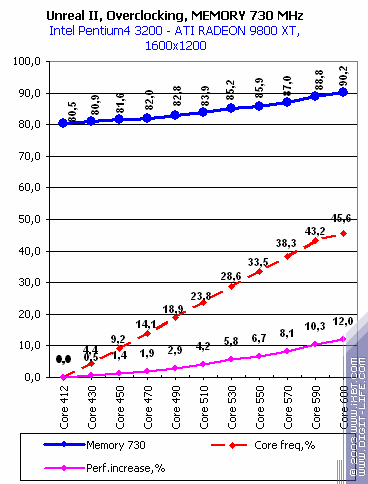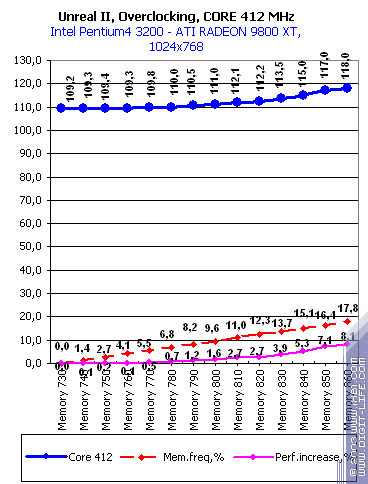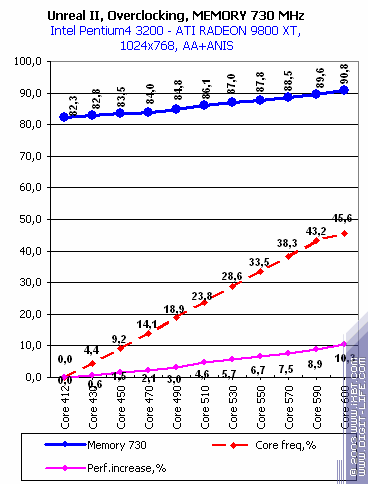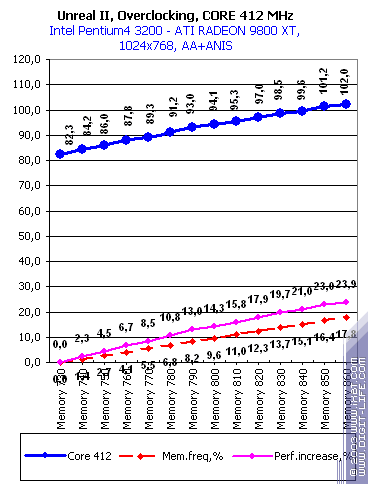ATI RADEON 9800 XT: Extreme Overclocking
|

CONTENTS
-
Introduction
-
Testbed, test tools
-
Test results: extreme overclocking at -15°C
-
Conclusion
As always, winter brings real frost and snow, and we got a good chance
test our cards in frosty conditions...
...You ask why does the collage reflect summer? Well, first of all,
winter is not everywhere - the southern hemisphere got summer and the peak
of heat right now:-). Secondly, we are speaking about overclocking today,
and the picture shows that the card is able to jump far ahead.
So, we are overclocking today one of the most powerful cards. The GeForce
FX 5900 Ultra already went through such test, the GeForce FX 5950 Ultra
wouldn't differ much from it, that is why it doesn't make sense to come
back to the whole family. At the same time, the RADEON 9800 XT hasn't been
yet in its shoes.
But before we start overclocking the card have a look at the list of
reviews devoted to the RADEON 9800.
Theoretical materials and reviews of video cards which concern functional
properties of the GPU ATI RADEON 9500/9700/9800
- Analysis of RADEON 9700
architecture and Microsoft DirectX 9.0
- ATI RADEON 9700 Pro
128MB Review
- Gigabyte MAYA II
R9700Pro 128MB - performance estimated on the new Pentium 4
2.53 GHz based platform, comparison with the NVIDIA's 40.41 driver
- Hercules 3D Prophet
9700 Pro 128MB - new CATALYST 2.3 driver estimated in 3DMark2001
SE, and Unreal Tournament 2003 DEMO final release
- PowerColor Evil Commando2 RADEON 9700 Pro 128MB
- performance of the new CATALYST 2.3 driver estimated in game tests,
3D quality issues
- Hercules 3D Prophet
9700 Pro on ATI RADEON 9700 Pro: extreme overclocking
- ATI RADEON 9500, 9700
and Gigabyte MAYA II RADEON 9500
- Sapphire Atlantis
RADEON 9500 128MB and videocards tests in DOOM III v.0.02
- ATI RADEON 9500 PRO
128MB
- Gigabyte MAYA
II RADEON 9500 PRO and Hercules 3D Prophet 9500 PRO - detailed
analysis of anisotropic filtering of RADEON 9700
- Sapphire Technology
RADEON 7500, 8500, 9000/Pro, 9700 Pro, anisotropic filtering
of RADEON 9700
- HIS Excalibur RADEON
9700 PRO - Tests in DirectX 9.0 RC0
- ATI RADEON
9500 64MB, 9500 128MB, 9500 PRO, 9700 and 9700 PRO in DirectX 9.0:
Part 1 - Game tests in 3DMark2001, and Soft9700!
- ATI RADEON
9500 64MB, 9500 128MB, 9500 PRO, 9700 and 9700 PRO in DirectX 9.0:
Part 2 - Tests in DirectX 9.0 - synthetic tests from RightMark 3D
- Sapphire
Atlantis RADEON 9700 and RADEON 9700 PRO Ultimate Edition
- YUAN SmartVGA RADEON
9000 64MB and RADEON 9700 PRO
- Connect3D video
cards on the ATI's chips
- ATI RADEON 9800 PRO
128MB
- ATI RADEON 9600 PRO 128MB: Part 1 - game
tests and performance
- Hercules 3D Prophet 9800 PRO 128MB
and Hercules 3D Prophet 7500 128MB, and scandal around the 3DMark03
- Hercules 3D Prophet 9800 PRO 128MB
and Hercules 3D Prophet 7500 128MB (single page)
- Sapphire Technologies ATI RADEON 9200/9600/9600PRO/9800PRO
video cards
- Connect3D, Gigabyte and CP.Technology
ATI RADEON 9800 PRO video cards
- Sapphire Atlantis RADEON 9600 256MB, Sapphire
Atlantis RADEON 9600 PRO Ultimate Edition 128MB, Gigabyte RADEON
9600 PRO 128MB, Hercules 3D Prophet 9600 PRO 128MB
- Sapphire Atlantis RADEON 9200 PCI 64MB
64bit, Sapphire Atlantis RADEON 9200SE 128MB, Sapphire Atlantis
RADEON 9800SE 128MB 128bit, Sapphire Atlantis RADEON 9800 128MB,
Sapphire Atlantis RADEON 9800 PRO Lite 128MB, PowerColor RADEON
9800SE 128MB 256bit
- ATI RADEON 9800 XT 256MB
- TYAN TACHYON G9800Pro-M 128MB on ATI
RADEON 9800 PRO
- ASUSTeK ATI RADEON 9200SE/9600SE/9600XT/9800XT
cards
- Sapphire Atlantis RADEON 9800XT 256MB
and RADEON 9800SE 128bit
- Connect3D RADEON 9800 XT 256MB 256M
Traditionally we carry out the winter overclocking tests on the balcony
at the air temperature below 0. It has both strong and weak points relative
to overclocking in a freezer. The plus is that you don't have to prepare
your freezer and arrange all the components inside so that the cables can
reach them and the display. The minus is that you have to arrange all the
stuff near the balcony door so that there was a place for the display and
tester as well. Also, the tester can easily catch cold :)

So, one winter morning when the thermometer showed -12 C I tool out all
the stuff on the balcony that was covered with snow. Although it was frosty,
the coolers didn't stop and the hard drive struggled to remain alive. The
video card reached excellent scores (see below).
At the end I touched the card and cooler on the processor to make sure
they were warm - well, I contributed my mite into the global warming...)
First, I wanted to run 2-3 test games but then I realized that I could
endure only one of them. That was Unreal II as it reflects the most realistic
correlation of video cards' power for today.
Card
The Hercules 3D Prophet 9800 XT card tested today was already examined
before, and I'll just briefly remind you its specs:
| Hercules 3D Prophet 9800 XT 256MB |

|
| Hercules 3D Prophet 9800 XT 256MB |
| AGP x8/x4 interface, 256 MB DDR SDRAM memory in 8 chips
on both PCB sides.
Hynix (HY5DU573222)
2.5ns memory chips (corresponds to 400 (800) MHz), memory clocked at 365
(730) MHz, GPU at 412 MHz. 256 bit memory bus. |

|
| Comparison with the reference design, front view |
| Hercules 3D Prophet 9800 XT 256MB |
Reference card ATI RADEON 9800 XT |

|

|
| Comparison with the reference design, back view |
| Hercules 3D Prophet 9800 XT 256MB |
Reference card ATI RADEON 9800 XT |

|

|
This is actually a copy of the reference card.
Testbed and drivers
Testbed:
-
Pentium 4 3200 MHz based computer:
-
Intel Pentium 4 3200 MHz CPU;
-
DFI LANParty Pro875 (i875P) mainboard;
-
1024 MB DDR SDRAM;
-
Seagate Barracuda IV 40GB HDD;
-
Windows XP SP1; DirectX 9.0b;
-
ViewSonic P810 (21") and ViewSonic P817 (21")
monitors.
-
ATI 6.404 (CATALYST 3.10) driver.
VSync off, S3TC off in applications, OverDrive off.
Test results: Extreme Overclocking
Test application:
The today's tests are not traditional, it's the analysis of video card's
performance gain with independent overclocking of the core and memory at
the ambient temperature -12°C.
At such temperature the card worked steadily at 600/860 MHz (it also
operated at 610 MHz but not without artifacts).
Unreal II: The Awakening
Without AA and and anisotropy
Memory clock fixed, core clock changes






Core clock fixed, memory clock changes






Combined overclocking



AA and anisotropy enabled
Memory clock fixed, core clock changes






Core clock fixed, memory clock changes






Combined overclocking



|
Conclusion
-
At 1024x768 the performance is limited by the CPU clock (and by the system
as a whole), the gain was inconsiderable with AA and anisotropy disabled.
-
Overclocking in the heavy modes yields the 30% gain. The main bottleneck
is the memory which couldn't reach so great scores like the core. The modes
with AA and anisotropy enabled prove it: performance reacts mainly to the
memory clock growth, and it grows faster as the core clock goes up at the
high memory frequencies rather than at the low ones.
-
If the next product has the same architecture and the clock speeds around
600/1000 MHz, the performance of such card can be higher by approximately
40% relative to the current flagship (in heavy modes).
The tests were carried out just for love, and we do not urge you to take
your PC stuff out to the balcony :).
In our 3Digest you can find full comparison
characteristics for video cards of this and other classes.
Write a comment below. No registration needed!
|
|
 |
|
|
|


